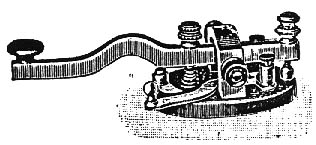
|

|
The Neuramœbimeter - continued...
In order to perform a time measurement, the experimenter first must cover the glass plate with soot, obtained by exposing it to the smoke of an turpentine or gas lamp. He then sets the spring into motion by manipulating a ring-like trigger mechanism situated opposite the telegraph key. The glass plate starts to move toward the operator and the needle is scratching its oscillatory movements into the soot. The registering process has begun. At this point, the test person already knows what to do. He or she is to react as quickly as possible to the clearly audible sound of the triggering mechanism. Pushing down the telegraph key removes the needle from the moving glass plate and brings the registering process to an end. Counting the numbers of recorded spring vibrations eventually gives the time for the reaction process, with a precision of up to 1/100 of a second.
|
|
 
|

 Traces of a Chronographic Tuning Fork. Taken from Marey, Jules É. 1875. La méthode graphique dans les sciences expérimentales. Physiologie Expérimentale. Travaux du laboratoire de M. Marey 1: 123-164, p.137.
Traces of a Chronographic Tuning Fork. Taken from Marey, Jules É. 1875. La méthode graphique dans les sciences expérimentales. Physiologie Expérimentale. Travaux du laboratoire de M. Marey 1: 123-164, p.137.

